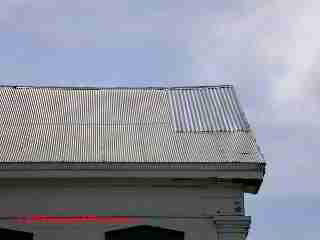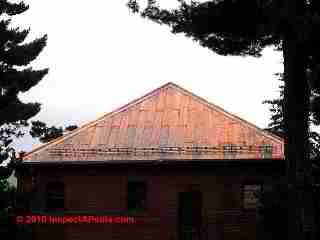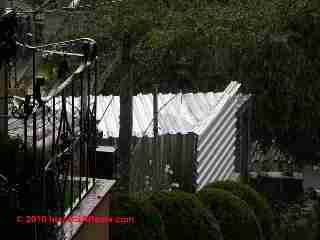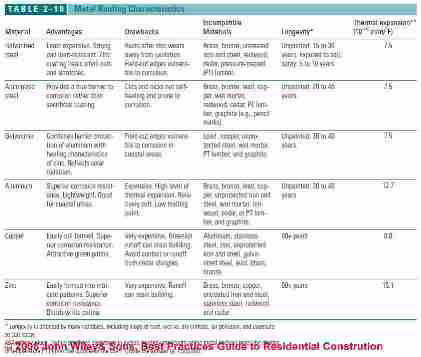 Comparing Metals Used in Metal Roof Systems
Comparing Metals Used in Metal Roof Systems
- POST a QUESTION or COMMENT about different metal types used in metal roofing
Types of metal used in roofing:
This article discusses the different types of metal used in metal roof systems, the properties of each metal, and their application, including galvanized steel roofs, aluminized steel roofs, galvalume roofing, aluminum roofs, copper roofs, and zinc metal roof systems. This article series discusses best practices in the selection and installation of residential roofing.
InspectAPedia tolerates no conflicts of interest. We have no relationship with advertisers, products, or services discussed at this website.
- Daniel Friedman, Publisher/Editor/Author - See WHO ARE WE?
A Comparison of Metal Choices for Roofing Systems
Adapted/paraphrased with permission from Best Practices Guide to Residential Construction (Steve Bliss, J Wiley & Sons) , chapter on BEST ROOFING PRACTICES: [Click any table or image to see an enlarged version.]
While some companies offer roofing products in copper, zinc, and stainless steel, the vast majority are coated steel and aluminum. Coated steel products are the most common and least expensive. In its favor, steel moves relatively little with temperature changes, has good structural characteristics, and resists denting. Its high melting point gives it a Class A fire rating.
All coated steel materials, however, are vulnerable to corrosion at field-cut edges— although Galvalume® is the least affected Table 2-10 below [Click to enlarge any image] lists the advantages, drawbacks, compatibility, and life expectancy of galvanized steel roofing, aluminized steel roofing, galvalume, aluminum, copper, and zinc metal roofing products.
[Click to enlarge any image]
Also see COMPLETE LIST OF TYPES & PROPERTIES of METALS USED in ROOF SYSTEMS
Aluminized Steel Metal Roofing System Properties
Developed in the 1950s, this is similar to galvanized steel, but it uses aluminum as the coating instead of zinc. The aluminum provides a physical barrier against corrosion and creates a reflective surface that helps reduce heat transfer to attics. However, aluminum does not have the self-healing properties of zinc, so exposed edges and scratches are more susceptible to rust.
Aluminized steel generally outlasts galvanized steel but has largely been replaced in the market by Galvalume® Metal Roofing
Aluminum Metal Roofing System Properties
Details about aluminum roofing materials are at ALUMINUM ROOFING, excerpts are below.
 Aluminum that is anodized or painted is
highly resistant to corrosion, making it well-suited to
coastal environments provided it is factory-coated with a suitable finish.
Aluminum that is anodized or painted is
highly resistant to corrosion, making it well-suited to
coastal environments provided it is factory-coated with a suitable finish.
Although lightweight aluminum flashings tend to pit and oxidize in salty air.
Aluminum roofing's light weight is an advantage in reroofing.
Aluminum roofing also reflects heat and may thus reduce building cooling costs in hot sunny climates.
Because of its high coefficient of expansion, however, attachment systems must be designed to accommodate the movement of long aluminum roof panels.
Also
see ROOF NOISE TRANSMISSION where we describe the noise transmission properties of metal roofing.
Copper Roof Metal Roofing System Properties
 This high-end material is highly resistant to corrosion
and easily formed into panels. Copper roofs have
been known to last for over a century and are a common
sight on churches and historic buildings.
This high-end material is highly resistant to corrosion
and easily formed into panels. Copper roofs have
been known to last for over a century and are a common
sight on churches and historic buildings.
Left unfinished, the material will oxidize to the familiar green patina (photo) that protects the underlying metal. In arid areas, the color may be more reddish-purple. Special clear acrylic coatings can be applied that will help copper retain its original color.
One concern is that runoff from a copper roof can stain
building components below if not managed with gutters.
Also, premature failure of copper flashing and roofing has
been linked to acid rain and runoff from cedar shingles
See FLASHING WOOD ROOF DETAILS
under
WOOD ROOF SHINGLE PROPERTIES
Clients interested in copper should consider a newly developed proprietary sheet metal called Suscop™, which has copper plating over a stainless-steel core. The material combines the strength and durability of steel with the natural patina of real copper. Because of its greater strength, a lighter-weight sheet (0.4mm) can be used in place of 16-ounce copper, significantly reducing material costs.
Details about copper roofing are found
at COPPER ROOFING.
Galvanized Steel Metal Roofing System Properties
 To protect against corrosion, the steel
is bonded to a layer of zinc, which works as a sacrificial
coating on the surface and also offers some protection to
cut edges and nicks by flowing to these areas. The heavier
the zinc coating, the longer the protection. The Metal Roofing
Alliance recommends G-90 galvanized steel for roofing,
which has 90 ounces of zinc per square foot.
To protect against corrosion, the steel
is bonded to a layer of zinc, which works as a sacrificial
coating on the surface and also offers some protection to
cut edges and nicks by flowing to these areas. The heavier
the zinc coating, the longer the protection. The Metal Roofing
Alliance recommends G-90 galvanized steel for roofing,
which has 90 ounces of zinc per square foot.
Also see COMPLETE LIST OF TYPES & PROPERTIES of METALS USED in ROOF SYSTEMSfor more about galvanized steel roofing.
Galvalume® Metal Roofing System Properties
Also sold under the trade names Zincalume ® and Galval®, Galvalume® was developed in the early 1970s. The underlying steel is coated with a zinc aluminum alloy that combines the long-lasting protection of aluminum with the self-healing properties of zinc.
Details about Galvalume® are
Also see A Complete List of Types & Properties of Metal Used in Roof Systems for more about Galvalume.
Stainless Steel Roofing System Properties
Stainless steel is generally a rust-resistant material but it's corrosion resistance to salt depends on the stainless steel alloy or grade. Also, stainless steel roofing durability depends on installation and ventilation details. Stainless steel grade 316) work well is suitable for salt-spray areas.
Terne coated stainless steel roof panels (Terne coating is a a zinc-tin alloy metal coating process that gives extra corrosion resistance. Other terne coatings using lead can present an environmental contamination worry from lead leachate found in roof runoff.)[1]
Because it is harder than aluminum metal roofing, stainless steel roof panels will be more resistant to impact damage from hail, and the metal also has less thermal expansion/contraction movement than either aluminum or copper roofs.
Watch out: other grades of stainless steel (SS 304) are not recommended for use near areas of salt spray such as close to oceans. And to avoid pitting-corrosion, stainless steel roof panels are installed using methods to provide panel ventilation on both the exposed and down-facing sides.
Details about terne metal roofing are at TERNE METAL ROOFING
Sources of Stainless Steel Roofing Products
- Corrugated Metal Roofing and Paneling, Stainless Steel, 82 Walker Lane, Newton PA 18940, Tel: 215-860-3600, http://www.corrugatedmetal.com/ including Stainless steel 303 machinable and corrosion resistant steel.
- Euro Inox, European Stainless Steel Development Association, http://www.euro-inox.org/ publishes a Technical Guide to Stainless Steel Roofing at http://www.euro-inox.org/htm/p_5_EN.html - Quoting
Reasons for Stainless Steel in Roofing In architectural applications, stainless steel is often used because of its attractive appearance. Facades, interior cladding, lifts and escalators, handrails and parapets are some of the most typical areas of stainless steel use. The family of stainless steels, however, has more to offer than just good looks. Its technical properties make it an ideal choice for many other building applications, in which additional durability requirements are essential.
Stainless steel is an alloy containing at least 10.5 % chromium 1). This gives the steel an inherent ability to protect itself from corrosion. Chromium in the steel reacts with oxygen
in the air and/or water to which the steel surface is exposed, and forms an invisible protective film of a chromium-rich oxide. If this layer is damaged, mechanically or chemically, it is spontaneously rebuilt if oxygen is present.
Corrosion resistance is increased with higher chromium levels and, additionally, by adding molybdenum to the alloy.
The presence of nickel improves formability and weldability. Nickel-containing stainless steels work-harden on cold forming and can thus give the fabricated part an additional structural function.
The most commonly used stainless steels have a chromium content of around 17 - 18% and a nickel content of 8 – 10.5%.
This is why they are known as "18/8" or "18/10". These chromium-nickel grades are called “austenitic stainless steels”
Another family of stainless steels are mainly alloyed with chromium and possibly other elements like Titanium. These are called “ferritic” grades. For roofing purposes, 12 - 17% chromium grades with organic or metallic coatings can be used.
- Flexospan Stainless Steel roofing and siding,PO Box 515, 253 Railroad St., Sandy Lake PA 16145, 800-245-0396, http://www.flexospan.com/ products: Flexbeam, Flexrib, Ventarib stainless steeel roofing panels.
- Follansbee Stainless Steel Roofing, see http://www.follansbeeroofing.com/ and Follansbee's description of their ZT Alloy steel roofing
- James River Steel, PO Box 11498, Richmond VA 23230, 800-825-0717, Email: info@jamesriversteel.com - Corrugated Stainless Steel Roof Panels, http://www.jamesriversteel.com/ - corrugated panels in stainless steel, flooring, aluminum, galvanized steel and fiberglass for industrial and architectural roofing, siding and decking.
- Stainless Steel Information Center, Specialty Steel Industry of North America, SSINA, 3050 K Street, N.W., Washington, DC 20007 Tel: (202) 342-8630 (800) 982-0355 http://www.ssina.com/
Zinc Metal Roofing System Properties
Zinc roofs are similar to copper in their durability and also similar to copper roofs in their installation procedures. But unlike copper, zinc roofs weather to a bluish-white color rather than green. Zinc has been used in construction for nearly two thousand years and its corrosion-protetive features when used on iron and steel has been familiar for about that long. Zinc roofing material, widely used in Europe, is very malleable and can be formed into intricate patterns for metal shingles.
Details about zinc metal roofing are at ZINC METAL ROOFING
Also see A Complete List of Types & Properties of Metal Used in Roof Systems
-- Adapted with permission from Best Practices Guide to Residential Construction (Steve Bliss, J Wiley & Sons) .
Resources: Roofing Materials & Equipment Suppliers
Where to Buy Metal Roofing: Manufacturers & Metal Roofing Sources, Associations
Metal Roofing
- Atas International www.atas.com Modular metal shingle, tile, and standing-seam panels
- Classic Products www.classicroof.com Modular metal shingle panels and standing seam panels
- Custom-Bilt Metals www.custombiltmetals.com Modular metal shakes and standing seam panels
- Decra Roofing Systems www.decra.com Modular metal shingle, tile, and shake panels
- Dura-Lok Roofing Systems www.duraloc.com Modular metal roofing shingles with granular coating
- Fabral www.fabral.com Exposed fastener and concealed clip metal roofing panels
- [1] Follansbee Steel Roofing, Follansbee WV 26037, Tel: 304-527-1260 800-624-6906, ZT Alloy (corrosion resistant terne-coated stainless steel roofing) - http://www.follansbeeroofing.com/
- Gerard Roofing Technologies www.gerardusa.com Modular metal shake and tile panels with granular coating
- Met-Tile www.met-tile.com Modular metal roof-tile panels
- Millenium Roof Tiles,550 East Centralia Street Elkhorn, WI 53121,Tel: 262-723-7778, produces stainless steel roofing tiles, 50-year warranty, http://www.millenniumtiles.com
- Zappone Manufacturing, website www.zappone.com/
Zappone Manufacturing, 2928 North Pittsburg St. Spokane, WA 99207 1-800-285-2677, Washington State Copper Roofing Supplier of Copper scallop shingles, copper shingles, copper bay windows, vertical walls, aluminum roof shingles
Venting Underlayments
Benjamin Obdyke www.benjaminobdyke.com Cedar Breather, a 3/8 -in.-thick matrix-type underlayment designed to provide ventilation and drainage space under wood roofing
More Information about Metal Roofing Materials, Methods, Standards
- Metal Roofing Alliance www.metalroofing.com
- American Galvanizers Association, "Zinc Coatings, A comparative analysis of process and performance characteristics", American Galvanizers Association, 6881 S. Holly Circle, Suite 108 Centennial, CO 80112 720-554-0900 | 800-468-7732 aga@galvanizeit.org www.galvanizeit.org
-- Adapted with permission from Best Practices Guide to Residential Construction (Steve Bliss, J Wiley & Sons) .
...
Reader Comments, Questions & Answers About The Article Above
Below you will find questions and answers previously posted on this page at its page bottom reader comment box.
Reader Q&A - also see RECOMMENDED ARTICLES & FAQs
Question: is there another term for a corroded metal roof?
(Feb 2, 2014) Anonymous said:
is there another term for a corroded metal roof?
Reply:
Sure: rusted. Or for metal that is very rusty and corroded such that it is flaking apart, we may use the term exfoliating rust.
(Dec 30, 2014) Lisa Anderson said:
Coatings also can be an excellent way to save your roof. Coating will stop the spread of rust. Many coating manufacturers also offer coatings in a variety of colors allowing to select a coating that blends in with other build components.
Question:
(Apr 20, 2015) Paul Balga said:
"Terne coated stainless steel roof panels (Terne coating is a a zinc-tin alloy metal coating process that gives extra corrosion resistance. Other terne coatings using lead can present an environmental contamination worry from lead leachate found in roof runoff.)" Question-- the steel portion of terne coated panels is not stainless, is it? I'm confused by the terminology used here because it implies a zinc coating is being placed on material that is already stainless, as opposed to the terne coating creating the stainless property.
Reply:
Paul, thanks for the question:
Details about terne metal roofing are at TERNE METAL ROOFING
at
inspectapedia.com/roof/Terne_Metal_Roofing.php
there we discuss both standards for terne coatings and the composition of different alloys used for Terne coatings.
Some metal roofing is Terne coated stainless but certainly not all. Other metals are used, as we list in the article above. Keep in mind that depending on its particular alloy mix, some stainless steels will indeed rust and thus could benefit from a corrosion-resistant coating.
...
Continue reading at MODULAR METAL ROOF SHINGLE SYSTEM or select a topic from the closely-related articles below, or see the complete ARTICLE INDEX.
Or see these
Recommended Articles
Suggested citation for this web page
METALS USED IN ROOFING at InspectApedia.com - online encyclopedia of building & environmental inspection, testing, diagnosis, repair, & problem prevention advice.
Or see this
INDEX to RELATED ARTICLES: ARTICLE INDEX to BUILDING ROOFING
Or use the SEARCH BOX found below to Ask a Question or Search InspectApedia
Ask a Question or Search InspectApedia
Try the search box just below, or if you prefer, post a question or comment in the Comments box below and we will respond promptly.
Search the InspectApedia website
Note: appearance of your Comment below may be delayed: if your comment contains an image, photograph, web link, or text that looks to the software as if it might be a web link, your posting will appear after it has been approved by a moderator. Apologies for the delay.
Only one image can be added per comment but you can post as many comments, and therefore images, as you like.
You will not receive a notification when a response to your question has been posted.
Please bookmark this page to make it easy for you to check back for our response.
IF above you see "Comment Form is loading comments..." then COMMENT BOX - countable.ca / bawkbox.com IS NOT WORKING.
In any case you are welcome to send an email directly to us at InspectApedia.com at editor@inspectApedia.com
We'll reply to you directly. Please help us help you by noting, in your email, the URL of the InspectApedia page where you wanted to comment.
Citations & References
In addition to any citations in the article above, a full list is available on request.
- American Galvanizers Association, "Zinc Coatings, A comparative analysis of process and performance characteristics", American Galvanizers Association, 6881 S. Holly Circle, Suite 108 Centennial, CO 80112 720-554-0900 | 800-468-7732 aga@galvanizeit.org www.galvanizeit.org
- Architectural elements: the technological revolution: Galvanized iron roof plates and corrugated sheets; cast iron facades, columns, door and window caps, ... (American historical catalog collection), Diana S Waite, available used out of Amazon.
- "Choosing Roofing," Jefferson Kolle, January 1995, No. 92, Fine Homebuilding, Taunton Press, 63 S. Main St., PO Box 5506, Newton CT 06470 - 800-888-8286 - see http://www.taunton.com/FineHomebuilding/ for the magazine's website and for subscription information.
- [1] Follansbee Roofing, Follansbee WV 26037, Tel: 800-624-6906, website: www.follansbeeroofing.com and http://www.follansbeeroofing.com/products/TerneII.aspx Quoting Follansbee on TerneII properties:
Follansbee Steel is the only manufacturer of a pre-painted or natural Terne roof and is a leading supplier of metal roofs for new and retrofit commercial, institutional, residential and historic preservation projects.Terne II - Classic Terne-Coated Steel ... is a new and improved version of historic Terne metal, ... Terne II has improved capability for resisting corrosion in all environments ... also has excellent formability, solderability, and affinity for paint ... without compromising mechanical characteristics. It can be used in flatlock, standing seam, vertical wall designs and virtually any other application in which original Terne has been used. It is strong and ductile, having high yield and tensile strengths as well as workability. This new material can easily be formed with conventional roofing tools.
With Terne II roofing, it is advisable to paint the material as soon as conditions permit. Oxide formation is slower than with the original Terne and the wait for proper painting conditions provides substantially less risk. The new material is coated with Follansbee's new ZT® alloy, a combination of zinc and tin. This coating is designed not only as a barrier but also to be anodic to the steel substrate and reduce the potential for oxidation before painting.
The traditional oil-based paints long required on original Terne are not recommended for application on Terne II. Follansbee's Rapidri paint with its faster drying time and ease of application is much superior to the old painting system. The Rapidri acrylic paints are aesthetically pleasing while offering enhanced durability and color retention. ...
- Metal Roofing Alliance, E. 4142 Hwy 302, Belfair, WA 98528, Telephone:(360) 275-6164, Customer Support 410-534-6900, Email: support@metalroofing.com,
Website: www.metalroofing.com. Quoting:
The Metal Roofing Alliance was formed in 1998 by a small group of forward-thinking metal roofing manufacturers with the main goal of educating consumers about the many benefits of metal roofing. Since our inception, we've shown millions of people just how beautiful, durable and money-saving metal roofing can be for them. Over the years, our membership has grown to include paint companies, material suppliers, industry publications and more. Be sure to take advantage of all of the great resources our members offer. - The Metal Initiative, 4700 W. Lake Ave., Glenview, IL 60025, P:847.375.4785 Website: www.themetalinitiative.com/, Email: Louise Ristau lristau@connect2amc.com Quoting:
The Metal Initiative is a coalition of manufacturers, individuals and associations that have come together to provide information on the features and benefits of metal in construction. Carrying its message of metal primarily to the professional building owner community, The Metal Initiative seeks to gather and disseminate useful information for decision-makers. - Metal Roofing, an Illustrated Guide, R.A. Knowlton , [metal shingle roofs],
- Copper Roofing, by CDA
- Copper Roofing, Master specifications for copper roofing and sheet metal work in building construction: Institutional, commercial, industrial, I.E. Anderson, 1961 (hard to find)
- Corrugated Iron, Building on the Frontier, Simon Holloway
- Problems in Roofing Design, B. Harrison McCampbell, Butterworth Heineman, 1991 ISBN 0-7506-9162-X (available used)
- Grapevine Design Guidelines - Web Search 07/12/2010
- "Copy on file as - /roof/Asbestos-to-Zinc_Metal_Roofing_NPS.pdf - From Asbestos to Zinc, Roofing for Historic buildings, Metals - ", Technical Preservation Services, National Park Service, U.S. Department of the Interior, web search 9./29.10, original source:
http://www.nps.gov/history/hps/tps/roofingexhibit/metals2.htm - "Copy on file as - /roof/Asbestos-to-Zinc_Metal_Roofing_NPS_3.pdf - From Asbestos to Zinc, Roofing for Historic buildings, Metals-part II, Coated Ferrous Metals: Iron, Lead, Zinc, Tin, Terne, Galvanized, Enameled Roofs - ", Technical Preservation Services, National Park Service, U.S. Department of the Interior, web search 9./29.10, original source:
http://www.nps.gov/history/hps/tps/roofingexhibit/metals.htm - "On file as /roof/Asbestos-to-Zinc_Metal_Roofing_NPS_2.pdf - From Asbestos to Zinc, Roofing for Historic buildings, Metals- Roofing Today - ", Technical Preservation Services, National Park Service, U.S. Department of the Interior, web search 9./29.10, original source:
http://www.nps.gov/history/hps/tps/roofingexhibit/roofingtoday.htm - Sweetser, Sarah M., ROOFING for HISTORIC BUILDINGS [PDF] (1978) Preservation Brief 4, Technical Preservation Services, National Park Service, U.S. Department of the Interior, web search 9./29.10, original source: http://www.nps.gov/history/hps/tps/briefs/brief04.htm
- Park, Sharon C., AIA, THE USE OF SUBSTITUTE MATERIALS ON HISTORIC BUILDING EXTERIORS [PDF] Preservation Brief 16, Technical Preservation Services, National Park Service, U.S. Department of the Interior, web search 9./29.10, original source:
http://www.nps.gov/history/hps/tps/briefs/brief16.htm - ARMA - Asphalt Roofing Manufacturer's Association - Asphalt Roofing Manufacturer's Association - https://www.asphaltroofing.org/
750 National Press Building, 529 14th Street, NW, Washington, DC 20045, Tel: 202 / 207-0917 - NRCA, Smith, Thomas L., AIA, CRC, METAL ROOFING: 'FIXING' FOR THERMAL MOVEMENT [PDF] Professional Roofing, [date pending] p. 72, NRCA - Web: http://www.nrca.net/
- NRCA, Smith, Thomas L., AIA, CRC, METAL ROOF SYSTEMS: DESIGN CONSIDERATIONS FOR SNOW AND ICE [PDF] Professional Roofing, [date pending] p. 74, NRCA, http://www.nrca.net/
- NRCA, Smith, Thomas L., AIA, CRC, STEEL [ROOF] DECK CORROSION BULLETIN [PDF] Professional Roofing, [date pending] p. 58, NRCA, http://www.nrca.net/
- "Steel [Roof] Deck Corrosion Bulletin, NRCA [ copy on file as /roof/Steel_Roof_Deck_Corrosion_NRCA.pdf ] - ", Thomas L. Smith, AIA, CRC., Professional Roofing, [date pending] p. 58, NRCA
- NRCA, Smith, Thomas L., AIA, CRC, THE MANY ASPECTS of METAL [ROOF] SHINGLES [PDF] Professional Roofing, [date pending] NRCA, Web: nrca.net
- NRCA - National Roofing Contractors Association, 10255 W. Higgins Road, Suite 600, Rosemont, IL 60018-5607, Tel: (847) 299-9070, Web: nrca.net,
- ASTM International, 100 Barr Harbor Drive, PO Box C700, West Conshohocken, PA, 19428-2959 USA The ASTM standards listed below can be purchased in fulltext directly from http://www.astm.org/
- NRCA - National Roofing Contractors Association, 10255 W. Higgins Road, Suite 600, Rosemont, IL 60018-5607, Tel: (847) 299-9070, Web: nrca.net,
- UL - Underwriters Laboratories - https://www.ul.com/
2600 N.W. Lake Rd.
Camas, WA 98607-8542
Tel: 1.877.854.3577 / Fax: 1.360.817.6278 E-mail: cec.us@us.ul.com - Our recommended books about building & mechanical systems design, inspection, problem diagnosis, and repair, and about indoor environment and IAQ testing, diagnosis, and cleanup are at the InspectAPedia Bookstore. Also see our Book Reviews - InspectAPedia.
- In addition to citations & references found in this article, see the research citations given at the end of the related articles found at our suggested
CONTINUE READING or RECOMMENDED ARTICLES.
- Carson, Dunlop & Associates Ltd., 120 Carlton Street Suite 407, Toronto ON M5A 4K2. Tel: (416) 964-9415 1-800-268-7070 Email: info@carsondunlop.com. Alan Carson is a past president of ASHI, the American Society of Home Inspectors.
Thanks to Alan Carson and Bob Dunlop, for permission for InspectAPedia to use text excerpts from The HOME REFERENCE BOOK - the Encyclopedia of Homes and to use illustrations from The ILLUSTRATED HOME .
Carson Dunlop Associates provides extensive home inspection education and report writing material. In gratitude we provide links to tsome Carson Dunlop Associates products and services.


